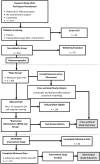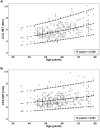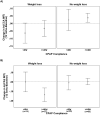Predictors for carotid and femoral artery intima-media thickness in a non-diabetic sleep clinic cohort
- PMID: 34086802
- PMCID: PMC8177540
- DOI: 10.1371/journal.pone.0252569
Predictors for carotid and femoral artery intima-media thickness in a non-diabetic sleep clinic cohort
Abstract
Introduction: The impact of sleep disordered breathing (SDB) on arterial intima-media thickness (IMT), a surrogate measure for cardiovascular disease, remains uncertain, in part because of the potential for non-SDB vascular risk factor interactions. In the present study, we determined predictors for common carotid (CCA) and femoral (CFA) artery IMT in an adult, sleep clinic cohort where non-SDB vascular risk factors (particularly diabetes) were eliminated or controlled.
Methods: We recruited 296 participants for polysomnography (standard SDB severity metrics) and CCA/CFA ultrasound examinations, followed by a 12 month vascular risk factor minimisation (RFM) and continuous positive pressure (CPAP) intervention for participants with a range of SDB severity (RFM Sub-Group, n = 157; apnea hyponea index [AHI]: 14.7 (7.2-33.2), median [IQR]). Univariable and multivariable linear regression models determined independent predictors for IMT. Linear mixed effects modelling determined independent predictors for IMT change across the intervention study. P<0.05 was considered significant.
Results: Age, systolic blood pressure and waist:hip ratio were identified as non-SDB predictive factors for CCA IMT and age, weight and total cholesterol:HDL ratio for CFA IMT. No SDB severity metric emerged as an independent predictor for either CCA or CFA IMT, except in the RFM Sub-Group, where a 2-fold increase in AHI predicted a 2.4% increase in CFA IMT. Across the intervention study, CCA IMT decreased in those who lost weight, but there was no CPAP use interaction. CFA IMT, however, decreased by 12.9% (95%CI 6.8, 18.7%, p = 0.001) in those participants who both lost weight and used CPAP > = 4hours/night.
Conclusion: We conclude that SDB severity has little impact on CCA IMT values when non-SDB vascular risk factors are minimised or not present. This is the first study, however, to suggest a potential linkage between SDB severity and CFA IMT values.
Trial registration: Australian New Zealand Clinical Trials Registry, ACTRN12611000250932 and ACTRN12620000694910.
Conflict of interest statement
The authors have declared that no competing interests exist.
Figures



Similar articles
-
Sleep disordered breathing has minimal association with retinal microvascular diameters in a non-diabetic sleep clinic cohort.PLoS One. 2023 Jan 10;18(1):e0279306. doi: 10.1371/journal.pone.0279306. eCollection 2023. PLoS One. 2023. PMID: 36626381 Free PMC article. Clinical Trial.
-
Markers of cardiovascular disease risk in sleep-disordered breathing with or without comorbidities: the Nagahama study.J Clin Sleep Med. 2021 Dec 1;17(12):2467-2475. doi: 10.5664/jcsm.9460. J Clin Sleep Med. 2021. PMID: 34170234 Free PMC article.
-
Carotid and femoral artery wall thickness and stiffness in patients at risk for cardiovascular disease, with special emphasis on hyperhomocysteinemia.Arterioscler Thromb Vasc Biol. 1998 Dec;18(12):1958-63. doi: 10.1161/01.atv.18.12.1958. Arterioscler Thromb Vasc Biol. 1998. PMID: 9848890
-
Intima-media thickness is a useful marker of the extent of coronary artery disease in patients with impaired renal function.Atherosclerosis. 2009 Feb;202(2):470-5. doi: 10.1016/j.atherosclerosis.2008.05.051. Epub 2008 Jun 5. Atherosclerosis. 2009. PMID: 18621374 Clinical Trial.
-
[Intima media thickness of the carotid arteries: early pointer to arteriosclerosis and therapeutic endpoint].Ultraschall Med. 2003 Jun;24(3):162-74. doi: 10.1055/s-2003-40058. Ultraschall Med. 2003. PMID: 12817310 Review. German.
Cited by
-
Sleep disordered breathing has minimal association with retinal microvascular diameters in a non-diabetic sleep clinic cohort.PLoS One. 2023 Jan 10;18(1):e0279306. doi: 10.1371/journal.pone.0279306. eCollection 2023. PLoS One. 2023. PMID: 36626381 Free PMC article. Clinical Trial.
References
Publication types
MeSH terms
Associated data
LinkOut - more resources
Full Text Sources
Medical

